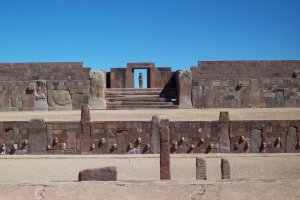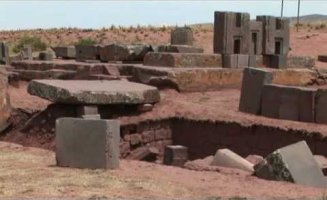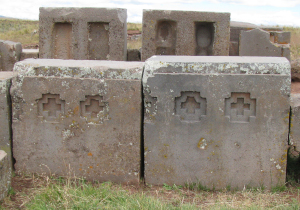
The mysterious ruins near the village of Tiwanaku (Spanish:
"Tiahuanaco" or
"Tiahuanacu") on the south shore of Lake Titicaca in what is now
Bolivia, could possibly be the oldest remains of a city ever found on
Earth. It is not known for what kind of purpose it was build, although it is
believed to be a ceremonial site.
 The site as
seen as today is an extensive reconstruction from the
1960s. It includes features that are entirely modern (extensive walls)
and may not replicate the original site, which current archaeology
believe had stone groupings and non-continuous walls. (See image on the
right.) The impressive "Gateway of the Sun" was actually built in a
different location.
The site as
seen as today is an extensive reconstruction from the
1960s. It includes features that are entirely modern (extensive walls)
and may not replicate the original site, which current archaeology
believe had stone groupings and non-continuous walls. (See image on the
right.) The impressive "Gateway of the Sun" was actually built in a
different location.
There are researchers who think
that the site could be 14,000 years old. After almost fifty years of
investigation, the Polish engineer Arthur Posnansky concluded that
Tiwanaku would be more than 15,000 years old if the temple
of Kalasasaya originally would be aligned with true north, east,
south and west, based on the tilt of the eath during that time. His
assertion is supported by many astronomical orientations at the site,
which are pointing in the direction of this date. On the walls of the
complex there are embedded statues of human heads but strangely
enough there are also depictions of strange looking animals which
look like toxodons,
which according to modern archaeology would have been extinct sinds
the end of the Pleistocene, some 12,000 years ago.
In the year
1523, local American Indians told the Spaniards that those gigantic
buildings where build in one night, long before the Incas. Another
legend tels that these cities where lifted through the air by the
sounding of trumpets, which may indicate that some kind of
ultra-sonic sound waves might have been used.

Part of the site of Tiwanaku is
known as Puma Punku, in the Bolivian Andes. The word "Puma Punku" is
Aymaran and translates to “Door of the Cougar”. Here there are huge
stone blocks (the heaviest block is weighing 440 tons) which
supposedly were part of a huge ancient but architectural advanced
construction, seemingly scattered around because of a natural disaster
like a great flood. (See the image on the left.)
The walls were made of solid interlocking multi-ton blocks of diorite,
an extremely hard rock, and have been carved with very precise angles
and shapes. Some even show what looks like tool marks; As if advanced
techniques like frasing and drilling where used. Stone cutting experts
agree that it would be nearly impossible for modern humans to duplicate
this precise cutting using primitive tools.
The Lake of Titicaca is a remarkable lake because the water
isn't fully sweet but also slightly salt because it had been a sea in
the past. At present the lake is situated 240 km from the Pacific
Ocean, but could once have been part of it. There is evidence
that lake Titicaca once was a salt water sea. The fishes and
seahorses in the lake are all oceanic types found only in salt water,
and its shoreline is littered with millions of fossilized
seashells.
 Archaeologists
claim that the Aymara Indians built
Puma Punku, but the Aymara themselves state that they did not; They
claim beings from a sunken continent in the Atlantic Ocean came and
did build these structures. There are also myths and legends
that tell that these people had flying machines which utilized a
fixed approach route. This may sound strange but the famous Nazca
lines in Peru are only visible from high in the air, and perhaps they
actually had the possibility to do so. Puma Punku seems to have been
a large construction that faced a mayor destruction as these huge
stone blocks seems to be tossed around with such great force as
perhaps only could have happened by a great tidal waves.
Archaeologists
claim that the Aymara Indians built
Puma Punku, but the Aymara themselves state that they did not; They
claim beings from a sunken continent in the Atlantic Ocean came and
did build these structures. There are also myths and legends
that tell that these people had flying machines which utilized a
fixed approach route. This may sound strange but the famous Nazca
lines in Peru are only visible from high in the air, and perhaps they
actually had the possibility to do so. Puma Punku seems to have been
a large construction that faced a mayor destruction as these huge
stone blocks seems to be tossed around with such great force as
perhaps only could have happened by a great tidal waves.
According
to the readings of Edgar Cayce, the Atlaneans established a colony in
Peru and northern Bolivia and Puma Punku was built as a port complex
on the former shore of lake Titicaca. This colony thus would probably
also encompassed the walls of Sacsayhuamán and Machu Picchu. Trance
clairvoyant Dr. Douglas James Cottrell also mentioned in one
of his sessions that Puma Punku had been built as an Atlantean port,
and he further vaguely explained how these blocks where heated and
carved out by some sort of ancient technology which relied on light
(laser) and sound (vibration). (See the Youtube video: Rev.
Douglas James Cottrell PhD: Puma Punku - sacred site of the Andes,
by Rammsteinregeln.)



